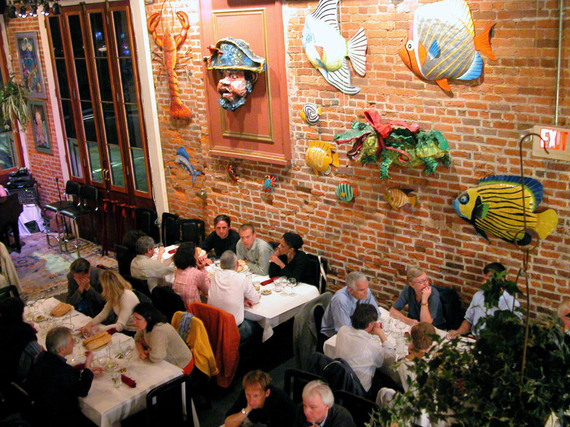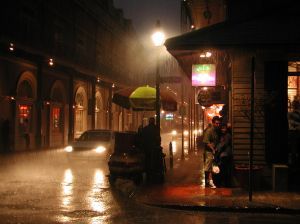As Fat Tuesday approaches in New Orleans, the parades have begun, and the season of eating has commenced.
Those of us who have connections to the city, but no longer live there, turn our thoughts to food. We often go to a local "New Orleans style" restaurant, hoping against hope that finally the new one got it right. We walk away with the sad taste of disappointment on our tongues.
It is my hope that every restaurant that claims to be of this type will send their chef to New Orleans to taste the real thing and learn from the pros. I would happily gather them in a group and take them on a food tour in order to avoid all the bad food I have tasted in the name of my beloved New Orleans.
Yelp reviews that scream "authentic" are no guide. Most of those reviewers have never been to New Orleans and if they have they never got outside the quarter. If one stays in the quarter and eats tourist swill, one has not experienced New Orleans.
1. There is no such thing as Voodoo Sauce. Giving something a New Orleans style name does not make it an authentic dish.
2. Jambalaya is not the thing you think it is. Dirty Rice is where it's at. Of course we eat Jambalaya, it is a popular party food prepared as a way to extend expensive seafood into something for a crowd. Few of our restaurants have it outside of the tourist venues. Of course, you can always get it at K-Paul's. At home we make a lot of dirty rice. It begins with chicken gizzards. Yup, offal, and we love it. The name comes from the ham water rice was cooked in, and it was a very popular depression dish, when flavored rice was all many families could afford.
3. There is no such thing as "Cajun seasoning." The Cajuns are complex and amazing chefs who eat a lot of wild game and classic recipes based on the French. Each dish will have it's own seasoning, and will often be much more complex than just a bunch of hot pepper.
4. Cajun and Creole are not interchangeable terms. Cajuns come from the French via Canada. Creole comes from Criolla, meaning a foot in two cultures. It encompasses French, African, German, Italian, Hungarian, Spanish and Haitian traditions and foods.
5. Blackening is a cooking technique, not a seasoning. If you see someone touting their "famous, blackened seasoning," run far, and run fast. In fact, is is a messy way to cook, and precious little food is blackened, save what we feed the tourists. To blacken food, turn the pan upside down and create a vortex of heat, pour butter on it and throw down your fish, cook quickly before it burns. Your kitchen may catch on fire, but done right, the result is delicious whatever the seasoning.
6. A Po Boy is about the bread and the mayonnaise, It is never dressed with a remoulade, or worse yet, a maple aioli. On yesterday's menu, I saw a deep fried turkey Po Boy dressed in remoulade sauce on crusty french bread. In New Orleans, our bread is crackly, not crusty. The high humidity prevents the hard crust from forming when it comes out of the oven. We can eat a big, high sandwich and the bread presses down and soaks up the gravy...that's right, gravy. Turkey and roast beef Po Boys are typically done with a gravy that mixes with the mayonnaise and soaks into the the bread.
7. We do eat red beans. Some with sausage, some with ham hocks, and in the ninth ward, you can still find some women who make them with smoked turkey butts. We even make them without meat. I have a friend in San Francisco who make his beans more creamy and unctuous than any chef in New Orleans. He is, of course, a native and knows instinctually how to make them perfectly. Some still make them every Monday.
8. We do eat beignets, mostly when tourists come to town. It is not our daily bread. When we visit, we always make a pilgrimage to Morning Call, or Cafe du Monde. That's it for the year.
9. In New Orleans, BBQ means butter when it refers to seafood. We also grill and smoke all kinds of meats, but do not expect your BBQ shrimp to have some nasty, sweet, red sauce.
10. Cornbread did not originate in the South. It came from the Northeast and is Native American in origin. It can be found in the South, we in New Orleans, we prefer our local breads and upon occasion a biscuit. We've even been known to eat toast with butter along with our morning grits and eggs.
11. Muffulettas are a really big deal. Central Grocery is the undisputed King of the Sandwich. Friends beg those visiting to bring one home in their luggage, wrapped in foil and put in a ziplock bag -- they travel well.
12. We love to stuff things, in addition to our bellies. One of my favorite dishes is a seafood stuffed Mirliton. Outside of New Orleans this is known as Chayote Squash. If you see this on a menu, you can probably trust the chef.
This list could easily go to 100. Here is my suggestion to all "New Orleans style" restaurants.
1. Send your chefs to New Orleans, get them to Commander's Palace and give them a taste of turtle soup and seafood prepared correctly. Guide them to all the small neighborhood dives for the local flavors. Keep them out of the French Quarter tourist traps.
2. If they still don't get it, stop hiring chefs from Brooklyn and look for a native. Otherwise, the natives in your city will give you one star on Yelp to counteract the fans who absolutely loved your Jambalaya style blacked rib eye with cajun seasoning topped with authentic voodoo sauce.

